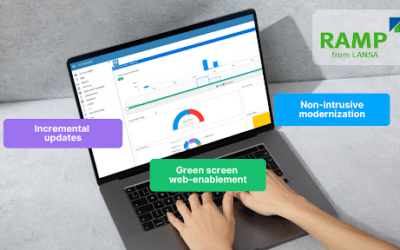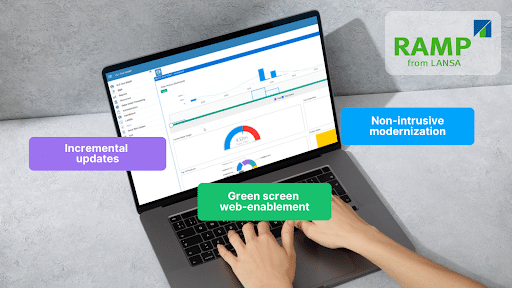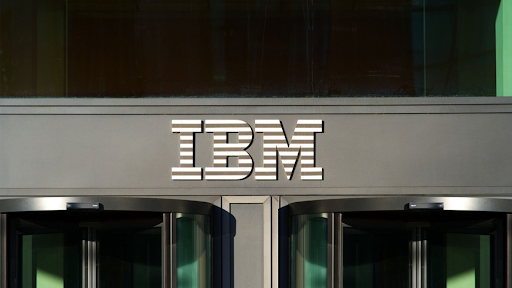The IBM i (formerly known as AS/400) stands out as the backbone of countless businesses and is known for its unmatched reliability, scalability, and security. For decades, it has been powering mission-critical applications across various sectors, from finance to manufacturing. However, as technology evolves at an unprecedented pace, many IBM i applications have struggled to keep up, becoming outdated, difficult to use, and costly to maintain. These legacy applications often face difficulty in integrating with modern technologies. LANSA resolves these issues with professional low-code.
LANSA provides a comprehensive suite of developer tools designed to assist businesses in rapidly implementing new and advanced software solutions. From enhancing user interfaces to improving integration and reducing maintenance costs, LANSA’s solutions enable businesses to meet the demands of today’s digital landscape.
The Legacy and Evolution of IBM i
Since its introduction in 1978, System/38 has been a midrange computer with options tailored for general businesses and service provisions for small businesses. IBM launched the AS/400 in 1988, which underwent several changes before becoming the i series in 2000, the System i in 2006, and eventually, IBM i Power Systems in 2008. Embraced across various sectors, IBM i has played a crucial role in corporate computing due to its reliability, security, and integrated DB2 database. It facilitates essential functions like production planning, quality control, and inventory management.
Over the years, IBM has rebranded its operating system and server multiple times to adapt to changing business requirements, showcase new technologies, and differentiate the platform within IBM’s portfolio.
The IBM i platform offers numerous valuable features for business environments. Its AS/400’s integrated architecture simplifies system management by combining hardware, software, and operating system components into a unified environment. This integration enhances overall efficiency and reduces complexity.
AS/400 is known for its high reliability and availability features, such as hardware redundancy, error detection, and correction mechanisms that contribute to minimizing downtime and providing continuous operation. This also has strong security features, including user authentication, authorization controls, and auditing capabilities. The security model is integral to the system’s design, delivering a secure computing environment for sensitive data and applications.
Moreover, IBM i systems are scalable, allowing organizations to expand their computing resources as needed. These features collectively establish IBM i an indispensable platform for modern businesses.
Key Challenges Faced by Businesses Using Legacy IBM i Systems
While legacy IBM i systems have been the backbone of countless businesses for their daily operations for years, they now present significant challenges in keeping pace with today’s constantly evolving digital landscape. From outdated software and integration problems to mounting security concerns and talent shortages, businesses relying on these legacy systems face a range of issues that can hinder their growth and competitiveness. Let’s take a look at some of the biggest issues faced by numerous organizations using legacy IBM i systems:
- Legacy Software: One of the primary challenges companies face while working with legacy IBM i hardware and software is performance bottlenecks, which lead to costly downtime and lost productivity. These outdated systems often struggle to meet the demands of today’s fast-paced business environments. Many businesses that continue to operate with legacy systems often lack the flexibility and scalability to support modern business processes, making maintenance and upgrades exceedingly difficult. This outdated legacy software impedes business growth and efficiency, slows operations, and causes frustrating delays, potentially leading to costly downtime and lost productivity.
- Integration: Integrating existing IBM i applications with modern software and platforms poses difficulties for many companies. The architecture of these legacy systems was not designed with today’s interconnected, API-driven ecosystems in mind, making integration a complex and time-consuming process. The lack of integration capabilities makes it difficult for companies to streamline workflows, share data across platforms, and incorporate new technologies. As a result, companies continue to work with outdated systems, leading to data silos, inefficiencies, and missed opportunities for automation and innovation.
- Security Concerns: With the increasing prevalence of cybercrimes, maintaining data security has become vital for every company. Legacy software is inherently vulnerable due to its outdated nature, which can lead to significant security risks for your organization. With time, cybercriminals’ skills have also advanced, and to protect against them, companies require modern security measures. Without regular patches and updates, these systems can become easy targets for cyberattacks, exposing sensitive business and customer data to potential breaches. Legacy software lacks advanced security features such as firewalls and encryption protocols, making it vulnerable to security breaches, data leaks, and malware attacks. Moreover, cybercriminals can exploit these weaknesses and hack the systems. Thus, It is critical to update your IBM i application with the latest security updates and utilize advanced security measures to safeguard your business and customer data.
- Cost of Maintenance: Maintaining and upgrading legacy IBM i applications can be costly for businesses. The expenses associated with hardware replacements, software updates, and ongoing technical support can strain a company’s budget. As these systems are outdated, they often require frequent repairs and maintenance, which drives up costs. Additionally, the specialized skills required to support legacy IBM i applications are becoming rare, making finding qualified personnel difficult and expensive. Not to mention, the software updates and ongoing support can drain the company’s budget. In some cases, the costs of running these applications can be more expensive than the cost associated with replacing your software.
- Talent Shortage: Another significant challenge is the scarcity of IBM i experts in the job market. It is rare to find skilled programmers who can manage, program, and maintain these legacy systems, as many of the experienced professionals are near retirement. Companies have a hard time recruiting, training, and retaining staff with the essential skills to manage their IBM i resources. Often, knowledge of legacy IBM i applications within a company resides with one individual and is difficult to document. When faced with the need to replace that team member without an ample handover period, this becomes a serious continuity concern.
LANSA: A Trusted Partner in the IBM i Environment
LANSA offers a whole host of solutions, ranging from IBM i modernization to system integration solutions, to help you upgrade your legacy applications and maximize existing investments. With LANSA, businesses can build highly responsive, customizable, secure, and scalable websites and applications that can be tailored to meet specific company requirements and needs. LANSA provides a comprehensive suite of software products designed to assist customers in rapidly implementing business solutions.
-
aXes:
The user interface is one of the most important parts of a web application. Legacy IBM i applications have outdated and inefficient user interfaces, hindering productivity and user satisfaction. aXes resolves this issue by transforming the green screen panels into web user interfaces without writing a single line of code. With this tool, you can easily change the way screens look and feel with well-designed tables, functional drop-downs, button themes, and more. For instance, J-oil Mills, a leading player in the food industry, faced the challenge of updating its legacy systems to meet its users’ needs. By utilizing aXes, it swiftly modernized its application interfaces, resulting in a more intuitive and efficient user experience.
Also read: Modernizing IBM i Applications: Transform Green Screen To GUI -
Visual LANSA:
One of the challenges businesses face with legacy IBM i systems is the complexity of developing new applications and modernizing existing ones. Visual LANSA addresses these challenges by providing a powerful low-code application development platform that simplifies application creation and modernization. It enables developers to work with a single language for both frontend and backend components, accelerating the development process. With its drag-and-drop wizards, templates, and unified language for full-stack development, Visual LANSA enables users to build applications with minimal coding effort. Its visual development environment is equipped with pre-designed templates and reusable components, allowing developers to craft and modify applications easily.
Also read: How Visual LANSA streamlines the development process
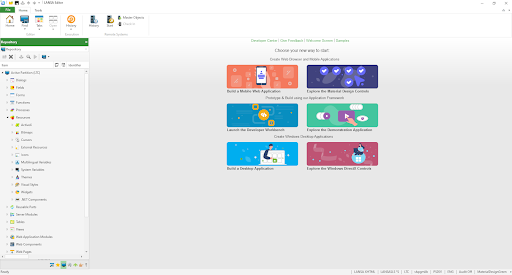
Visual LANSA serves as the foundation for advanced tools like LANSA Portalize and LANSA Commerce Edition. These tools leverage a professional low-code platform to offer customizable, scalable solutions tailored to modern business needs.
-
LANSA Commerce Edition:
Legacy IBM i applications often struggle to meet the demands of modern eCommerce environments, including seamless user experiences, the need for advanced functionalities, and robust security features. LANSA Commerce Edition resolves this issue by providing a suite of B2B components to businesses that enables them to build a highly customizable, fully integrated, and tailored eCommerce website. This advanced tool provides businesses with pre-built functionalities such as advanced navigation, security, and administration tools, enabling them to create sophisticated online stores that meet today’s high standards.
Also read: Enhancing Customer Experience with LANSA Commerce Edition
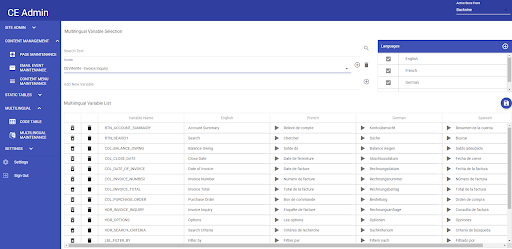
-
Portalize:
Businesses using legacy IBM i systems face difficulty in developing and managing modern application portals that offer advanced functionalities and user management capabilities. LANSA Portalize is designed to help businesses build secure, customizable, and scalable web portals at lightning speed. It simplifies the process of creating and maintaining customized portals, reducing the complexity associated with portal development. This solution provides developers with a fully functional and customizable portal framework equipped with essential features, allowing them to focus on creating engaging user experiences rather than dealing with backend complexities.
Also read: Portalize Magic: Building Superior User Experiences in Record Time
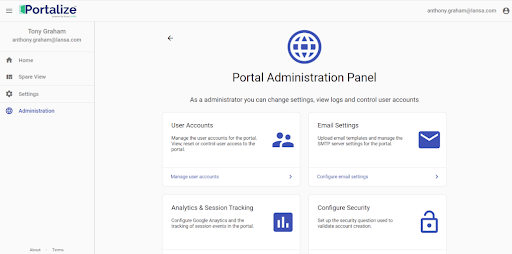
-
RAMP:
Differentiating your application from competitors involves offering unique features. LANSA’s RAMP tool enables you to incorporate new functionalities and integrate third-party software seamlessly. Additionally, it enables developers to build applications from scratch while using existing functionality. This allows you to create applications using modern technologies while retaining important functionality. Adding new features can be beneficial for you and your application, as it can expand your TAM (Total Addressable Market), improve efficiency, boost client retention, and keep your users engaged.
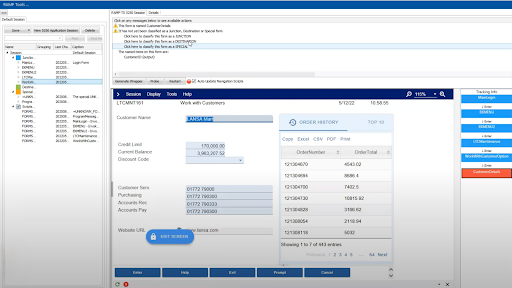
-
LongRange:
Legacy IBM i systems typically struggle to offer mobile capabilities, which can limit operational efficiency and restrict access to critical data and functions. LongRange is an advanced mobile application builder that allows developers to easily create native mobile applications for iPhone, iPad, and Android devices that completely interact with their IBM AS/400 and data using their current RPG, COBOL, and DDS expertise. This solution allows businesses to extend their legacy applications to mobile platforms, enhancing accessibility and functionality for users on the go. An illustrative case is Braum’s, a regional food and dairy retailer that used LongRange to develop a mobile application that integrated with its IBM i systems. This mobile solution provided their employees with enhanced tools for managing inventory and customer interactions.
-
LANSA BI
Businesses today are overwhelmed with the vast amounts of data and often struggle to turn it into actionable insights. Traditional BI tools like Db2 Web Query can be restrictive due to limited capabilities and slower performance, which makes it difficult to leverage the full potential of data. Switching to LANSA BI is a strategic move because of its significant enhancements in both data analysis and reporting capabilities. While Db2 Web Query provides essential querying and reporting functions, LANSA BI takes these capabilities further by offering seamless integration with your existing IBM i applications. Not only does LANSA BI allow you to access real-time insights effortlessly, but it also provides a wide array of advanced features like interactive dashboards, guided Natural Language Query (NLQ), AI-assisted insights generation, and data storytelling that significantly improve data visualization, reporting, and analysis allowing businesses to gain deeper insights and make data-driven decisions.
One of the LANSA BI’s biggest strengths is Embedded Analytics. It excels at embedding powerful analytics directly into business applications, improving decision-making processes without disturbing workflows. With LANSA BI, you can transform raw data into useful information and empower organizations to make data-driven decisions.
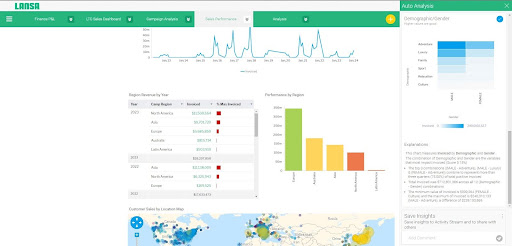
The Future of IBM i Applications Starts Here
Many organizations still use the IBM i to power business-critical applications. While it is a reliable and secure environment, legacy applications face significant challenges, including poor user experience, integration difficulties, and high maintenance costs. LANSA offers a comprehensive solution to address these. From modernizing existing applications to building new ones, LANSA’s professional low-code tools enable businesses to stay competitive in today’s digital landscape.
Get More Out of Your IBM i with LANSA
Upgrade your legacy applications with LANSA’s professional low-code solutions. LANSA offers a suite of tools, such as aXes, RAMP, LongRange, Visual LANSA, and LANSA BI, that simplify the process of modernizing IBM i applications. With advanced features for mobile extensions, real-time analytics, seamless integrations, and strong security, you can future-proof legacy systems and optimize performance.
Take the first step towards modernization and efficiency. Contact us today to schedule a consultation and see how LANSA can make your IBM i applications more dynamic and user-friendly.



